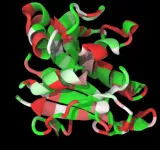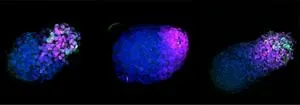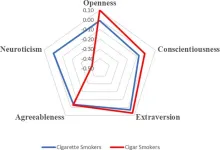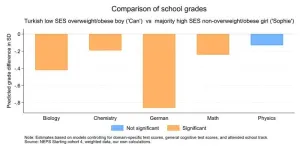(Press-News.org) A new study led by Rice University’s Peter Wolynes offers new insights into the evolution of foldable proteins. The research was published in the Proceedings of the National Academy of Sciences.
Researchers at Rice and the University of Buenos Aires used energy landscape theory to distinguish between foldable and nonfoldable parts of protein sequences. Their study illuminates the ongoing debate about whether the pieces of DNA that code for only part of a protein during their origins can fold on their own.
The researchers focused on the extensive relationship between exons in protein structures and the evolution of protein foldability. They highlighted the significance of exons, the parts of the gene that code for proteins, and introns, the silent regions discarded during gene translation into proteins.
“Using the extensive genomic exon-intron organization and protein sequence data now available, we explored exon boundary conservation and assessed its behavior using energy landscape theoretic measurements,” said Wolynes, the D.R. Bullard-Welch Foundation Professor of Science, professor of chemistry, biosciences, physics and astronomy and co-director of the Center for Theoretical Biological Physics (CTBP).
When genes in pieces were discovered in the 1970s, it was immediately proposed that by breaking up the sequence, this structure helped build foldable proteins. When researchers looked at this again in the 1990s, the existing data was equivocal, Wolynes said.
The team has now assessed exons as potential protein folding modules across 38 abundant and conserved protein families. Over generations, exons can shuffle randomly along the genome, leading to significant changes in genes and the creation of new proteins. The findings indicated deviations in the exon size distribution from exponential decay, suggesting there was evolutionary selection.
“Protein folding and evolution are closely linked phenomena,” said Ezequiel Galpern, a postdoctoral researcher at the University of Buenos Aires.
Natural proteins are linear chains of amino acids that typically fold into compact three-dimensional structures to perform biological functions. The specific sequence of amino acids dictates the final 3D structure. Therefore, the idea that exons translate into independently folded protein regions, or foldons, is very attractive.
Using computational methods, the researchers measured the likelihood of the amino acid chain coded by an exon to fold into a stable 3D structure, similar to the full protein. Their results showed that while not all exons led to foldable modules, the most conserved exons, consistently found in diverse organisms, corresponded with better foldons.
The study found a correlation between protein folding and evolution in certain globular protein families. Protein folding involves amino acid chains folding in space to perform biological functions within relevant timescales. This correlation is a fundamental concept in protein science, assessed using genomic data and energy functions.
Interestingly, the general trend did not hold for all protein families, suggesting that other biological factors may influence protein folding and evolution. The researchers’ work paves the way for future studies to understand these additional factors and their impact on evolutionary biology.
The research team includes Carlos Bueno, a postdoctoral researcher at CTPB; Hana Jaafari, an applied physics graduate student at Rice; and Diego U. Ferreiro, a professor at the University of Buenos Aires.
This study was supported by the Consejo Nacional de Investigaciones Científicas y Técnicas; the Bullard-Welch Chair at Rice; the University of Buenos Aires; NASA Astrobiology Institute; and CTPB.
END
Do genes-in-pieces code for proteins that fold in pieces?
2024-07-03
ELSE PRESS RELEASES FROM THIS DATE:
Can inflammation in early adulthood affect memory, thinking in middle age?
2024-07-03
MINNEAPOLIS – Having higher levels of inflammation in your 20s and 30s may be linked to having memory and thinking problems at middle age, according to a study published in the July 3, 2024, online issue of Neurology®, the medical journal of the American Academy of Neurology. The study looked at levels of C-reactive protein (CRP) in the blood. CRP is produced by the liver and increases when there is inflammation in the body. The study does not prove that having higher levels of this protein causes dementia. It only shows an association.
There are two kinds of inflammation. Acute inflammation happens when the body’s immune response jumps into action to fight off infection or ...
Poor health, stress in 20s takes toll in 40s with lower cognition
2024-07-03
Higher inflammation in young adulthood linked to lower performance in skills testing in midlife.
Young adults who have higher levels of inflammation, which is associated with obesity, physical inactivity, chronic illness, stress and smoking, may experience reduced cognitive function in midlife, a new study out of UC San Francisco has found.
Researchers previously linked higher inflammation in older adults to dementia, but this is one of the first studies to connect inflammation in early adulthood with lower cognitive abilities in midlife.
“We know from long-term studies that brain changes leading to Alzheimer’s ...
Scientists may have found how to diagnose elusive neuro disorder
2024-07-03
Progressive supranuclear palsy (PSP), a mysterious and deadly neurological disorder, usually goes undiagnosed until after a patient dies and an autopsy is performed. But now, UC San Francisco researchers have found a way to identify the condition while patients are still alive.
A study appearing in Neurology on July 3 has found a pattern in the spinal fluid of PSP patients, using a new high-throughput technology that can measure thousands of proteins in a tiny drop of fluid.
Researchers ...
Cracking the code for cerebellar movement disorders
2024-07-03
The cerebellum is a region of the brain that helps us refine our movements and learn new motor skills. Patients and mouse models experience many kinds of abnormal movements when their cerebellum is damaged. They can have uncoordinated and unbalanced movements, called ataxia. They can have atypical positioning of body parts or uncontrolled movements because their muscles are working against each other, called dystonia. Or they can have disruptive shaky movements, called tremors. Understanding how changes in a single brain region ...
Stability indicating RP-HPLC method for the estimation of impurities in esomeprazole gastro-resistant tablets by AQbD approach
2024-07-03
https://www.scienceopen.com/hosted-document?doi=10.15212/bioi-2024-0018
Announcing a new article publication for BIO Integration journal. Esomeprazole (ESO) gastro-resistant tablets (40 mg) are sold under the brand name, Zosa, which effectively manages conditions associated with the overproduction of gastric acid, including peptic ulcer disease and Zollinger-Ellison syndrome. This article quantifies impurities in esomeprazole using advanced analytical techniques known as analytical quality by design with high-performance liquid chromatography.
Buffer selection ...
Clinical implications and procedural complications in patients with patent foramen ovale concomitant with atrial septal aneurysm
2024-07-03
https://www.scienceopen.com/hosted-document?doi=10.15212/CVIA.2024.0038
Announcing a new article publication for Cardiovascular Innovations and Applications journal. Atrial septal aneurysm (ASA) is defined as excursion of the atrial septum exceeding 10 mm beyond the atrial septum into the right or left atrium, or a combined total excursion of 15 mm on the right and left sides during the cardiac cycle. According to previous studies, 20–40% of patent foramen ovale (PFO) cases are accompanied by ASAs. ASA is associated with the presence of PFO, left atrial dysfunction, cryptogenic stroke, migraine, and arterial embolism, thus making ...
Cryptocurrency investors are more likely to self-report “Dark Tetrad” personality traits alongside other characteristics
2024-07-03
Owning cryptocurrency may be associated with certain personality and demographic characteristics as well as a reliance on alternative or fringe social media sources, according to a study published July 3, 2024 in the open-access journal PLOS ONE by Shane Littrell from the University of Toronto, Canada, along with colleagues from the University of Miami, USA.
Anonymous trading and unregulated markets hallmark cryptocurrency’s unique subculture. While some consider the digital currency to be financially unreliable, hundreds of millions of global investors think otherwise.
This study identified various political, psychological, and social characteristics ...
Smoking behavior is linked to personality traits
2024-07-03
Cigarette smokers, cigar smokers, and non-smokers each have distinct personality profiles, according to a study published July 3, 2024 in the open-access journal PLOS ONE by Dritjon Gruda from Universidade Catolica Portuguesa, Portugal, and Jim McCleskey from Western Governors University, USA.
Tobacco use remains a formidable global public health challenge, responsible for more than 8 million deaths annually, including those attributed to second-hand smoke exposure. Emerging research underscores the critical role of psychological factors, including personality traits, in shaping ...
Minority status, social origin, gender, and weight can all count against a German kid’s grades
2024-07-03
A new study done in more than 14,000 ninth graders in Germany has revealed that students experience grading bias based on their gender, body size, ethnicity and parental socio-economic status. These negative biases stack on each other, meaning that students with multiple intersectional identities get significantly lower grades than their peers regardless of their true abilities. Richard Nennstiel and Sandra Gilgen of the University of Bern and University of Zurich in Switzerland present these findings in the open-access journal PLOS ONE on July 3, ...
Dengue linked to heightened short- and long-term risk of depression in Taiwan
2024-07-03
Analysis of the medical records of nearly 50,000 people who experienced dengue fever in Taiwan suggests that this disease is associated with elevated short- and long-term risk of depression. Hsin-I Shih and colleagues of National Cheng Kung University and National Health Research Institutes, Taiwan present these findings in the open-access journal PLOS Neglected Tropical Diseases.
People may develop dengue fever after being bitten by a mosquito carrying the dengue virus. Dengue fever can be mild, but it can also progress ...




